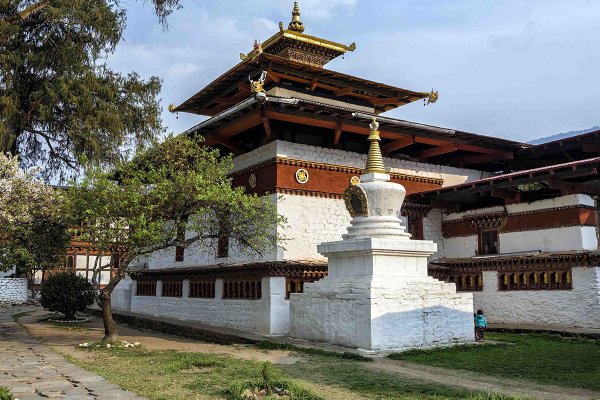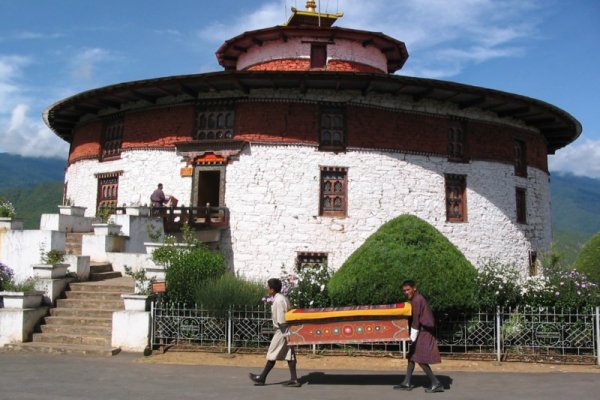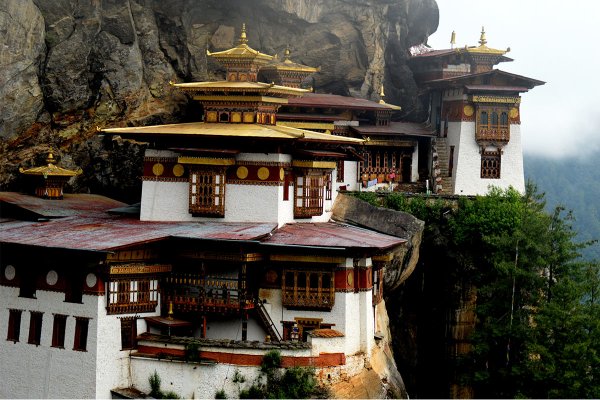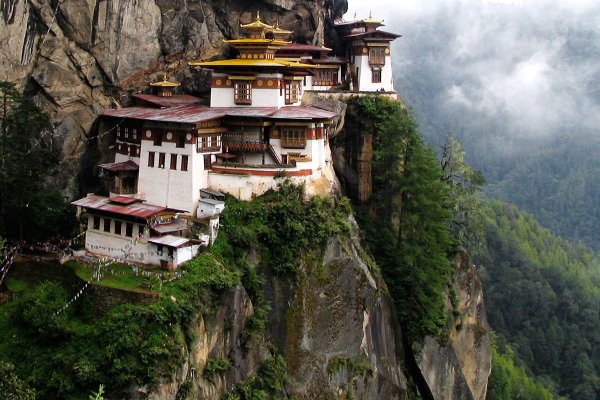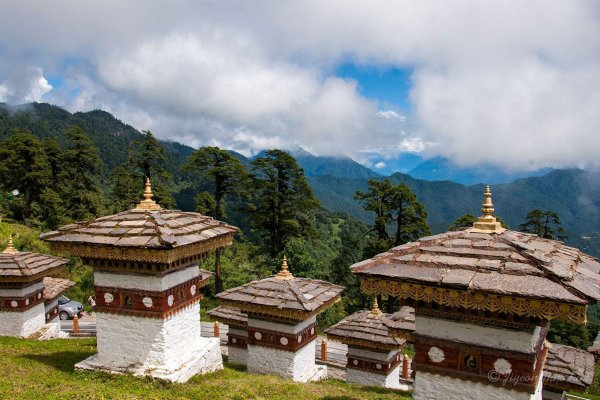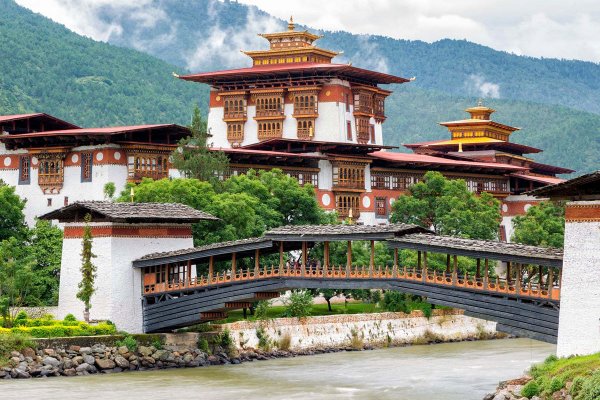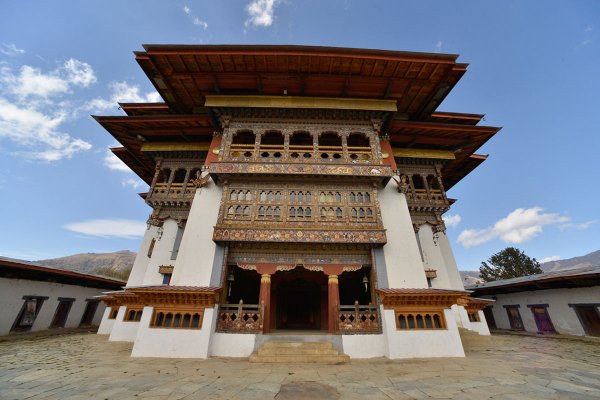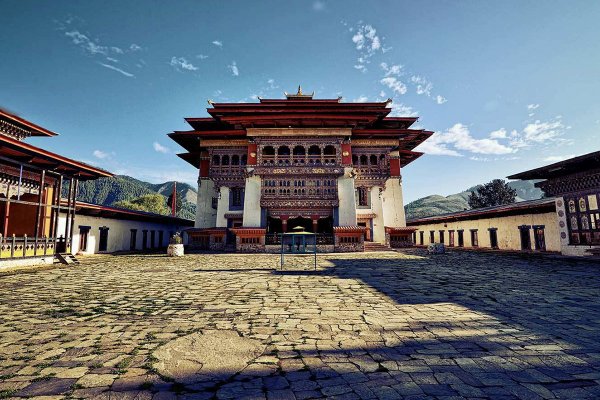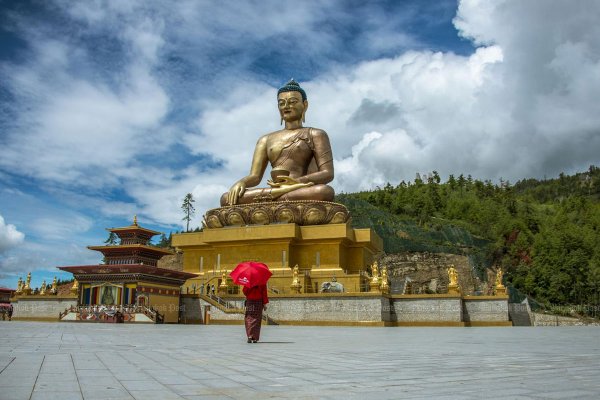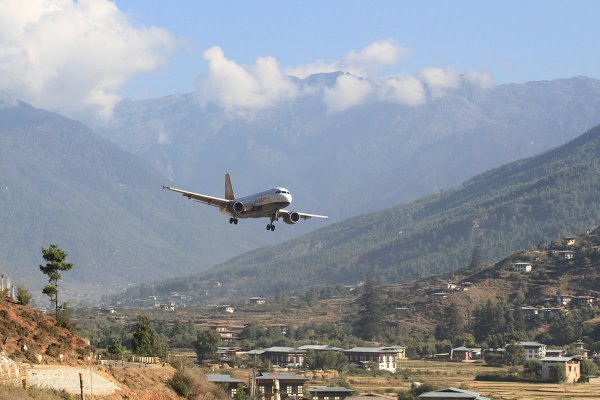BHUTAN ODYSSEYS OF DISTINCTION 6 DAYS 5 NIGHTS

Package Overview
Duration : 6 days & 5 nights
Price : $ 0.00
-
Day 1
After arriving at Paro International Airport, you will be welcomed by your dedicated certified guide, and after immigration & baggage collection you will proceed to your hotel in Paro.
After refreshment you will start your trip according to below itinerary with certified guide and dedicated vehicle.
Ta Dzong (National Museum)
Ta-Dzong, an ancient watchtower, which now houses the National Museum. It is located about five and a half kilometers away from the main town of Paro and 500 feet from the Rinpung Dzong located below the museum.
After completion of the Rinpung Dzong, the 2nd Desi Tenzin Drugda was appointed as the Paro Penlop during whose tenure the country was threatened by unceasing assaults from Tibet and India. Therefore, to protect the country from invaders and especially to protect the Paro Rinpung Dzong, Desi Tenzin Drugda together with Chhogyal Minjur Tenpa built the Ta Dzong (Ta-watch, Dzong-fortress) in the mid-seventeenth century. The Father of Modern Bhutan, the 3rd King Jigme Dorji Wangchuck renovated and converted it into the National Museum in 1968. Cameras are not allowed inside the museum, but you can take photographs of the Ta Dzong from outside and its surrounding grounds.
Rinpung Dzhong
The construction of the Paro Dzong began in 1644 on the order of Zhabdrung Ngawang Namgyal, the unifier of modern-day Bhutan. Unlike most of the other dzongs in Bhutan, it survived the massive 1897 earthquake though it was damaged by fire in 1906. Paro Dzong's full name is Rinpung Dzong, which means, the fortress of the heap of jewels.
In the 15th century, two brothersdescendants of Phajo Dugom Zhigpo, the founder of the Drukpa Kagyupa School in Bhutan-named Gyelchok andGyelzom lived in the Paro valley. Gyelzom established himself at Gangtakha Monastery, while his brother Gyelchok travelled to Tibet to study theology. When Gyelchok came back to Paro, he was not respected in the community, as he had become a pauper. His brother Gyelzom renounced his existence; in his eyes a beggar could not be part of the family. Gyelchok then moved to Humrelkha, a place which took its name from the guardian deity of Paro, Humrel Gyalpo. He built a five-storied structure, which would later become the Paro Dzong, on a bridge above the Paro Chu (Paro River).
It is said that at the base of the cliff was the La Tsho (Soul Lake) of the deity Jag Wog Nep. In 1644, Gyelchok, the Lord of Humrel, relinquished his small fort to Zhabdrung Ngawang Namgyal, thus recognizing his religious and political prowess. Immediately, the Zhabdrung began the construction of a much superior and more extensive fortress.
Tenzin Drugda was appointed as the first Penlop in 1646 and became the centre of a dual administration both spiritual and temporal. In 1906, during the time of the 23rd Penlop Dawa Penjor, the Dzong was burnt almost to the ground. All important relics and statues were lost to the fire and nothing could be salvaged except for the Thongdol, a 20x20 metre-wide Thangka. It is displayed to the public during the annual Paro Tshechu. With money raised by a special tax levied throughout Bhutan, the Dzong was immediately rebuilt to the original design by the Paro Penlop Dawa Penjor.
Kyichu Lhakhang
Kyichu Lhakhang was originally a small structure at the time of its establishment in the 7th century by the Tibetan Emperor Songtsan Gampo. It is considered to be one of the 108 border taming temples he built. It is believed the temple was visited by Padmasambhava in the 8th century and he concealed many spiritual treasures here.
In 1644 the temple was taken over by Ngawang Namgyal. From 1836 to 1838 the temple was restored and reconsecrated by the 25th Je Khenpo Sherab Gyaltshen.
In 1971, Kesang Choden Wangchuck, the queen of Jigme Dorji Wangchuck built a Guru Lhakhang next to the old Jowo Lhakhang which was consecrated by Dilgo Khyentse. Ever since then the annual rites of great accomplishment for the deities Vajrasattva, Palchen Heruka, and Vajrakilaya have been held in this temple for the well being of the country under the patronage of Kesang Choden Wangchuck.
There is a belief that the two orange trees in the courtyard of Kyichu Lhakhang bear fruit throughout the year.
Overnight stay hotel in Paro.
-
Day 2
Taktsang Lhakhang is Bhutan's most iconic landmark and religious site. The name Taktsang translates to The Tiger's Nest. This temple is one of the most holy sites in the kingdom and clings impossibly to a sheer cliff face 900 hundred meters above the Paro Valley. It it is believed that Padmasambhava (Guru Rinpoche) flew to this location from Tibet on the back of a tigress from Khenpajong. This place was consecrated to tame the Tiger demon, was first built in 1692 at a cave where Guru Rimpoche meditated in a cave, in the 7th century A.D. for 3 years, 3 months, 3 days and 3 hours in order to subdue evil demons residing within it. The cave has been considered a sacred site ever since and many famous saints have travelled to meditate in it.
Taktsang Lhakhang is located approximately 10 km north of Paro town at an altitude of 3.120 meters above the Paro valley, on the right side of the Paro River. In order to arrive at the temple you must trek for around 2-3 hours through beautiful, shady pine forests that is colorfully festooned with moss and prayer flags. On many days, clouds shroud the monastery and give an eerie feeling of remoteness.
On the approach path to the monastery, there is a Lakhang and a temple of Urgyan Tsemo which, like the main monastery, is located on a rocky plateau with a precipitous projection of several hundred feet over the valley. From this location, the monastery?s buildings are on the opposite ravine, which is known by the name Copper-Colored Mountain Paradise of Padmasambhava.
This is the view point for YOU and there is a cafeteria to provide refreshments.
The trek beyond this point is very scenic with the sound of the water fall breaking the silence. The route is scattered with number of temples. On this path, a large water fall, which drops by 60 meters (200 ft) into a sacred pool, is forded over by a bridge. The track terminates at the main monastery where colorful paintings are displayed. Guru Rinpoche's cave where he meditated is also seen. This cave is opened for public viewing only once a year.
No trip to Bhutan would be complete without a visit to this remarkable heritage site.
Druk choeding
Druk choeding also known as Tshongdoe Naktshang, the quiet andpeaceful Druk Choeding is the town temple. It was built in 1525 by Ngawang Chhogyel (1465-1540), one of the prince-abbots of Ralung in Tibet and an ancestor of the Zhabdrung Ngawang Namgyal.
The main statue is of a seated Jampa (future Buddha). Also present are the local protectors Gyenyen, Jichu Drakey and Hong Gyelri, surrounded by a fearsome collection of old Bhutanese shields and weapons.
Dumtse Lhakang
To the west of the road leading to the National Museum is Dumtse Lhakhang, an unusual chorten-like temple that was built in 1433 (some sources say 1421) by the iron-bridge builder Thangtong Gyalpo.
The temple was built to subdue a demoness and so is chained firmly to the ground. Its three floors represent hell, earth and heaven, and hold some of the finest murals in Bhutan. It's essential to bring a good torch. Your travel agency may need to have Dumtse listed on your permits, so mention you'd like to stop here in advance.
Overnight Hotel in Paro
-
Day 3
Dochula Pass
Dochula Pass known as the Druk Wangyal Chortens- the construction of these 108 chortens was commissioned by the eldest Queen Mother, Her Majesty Ashi Dorji Wangmo Wangchuk. The pass is also popular spiritual destination for both locals and tourists because an important(Druk Wangyal Lhakhang) temple is located on the crest of Dochula pass. This temple was built in honor of His Majesty the fourth Druk Gyalpo, Jigme Singye Wangchuck. The past and future appears to merge in the details of the lhakhang (temple) and its structure tells the story of a supreme warrior figure, whose vision pierces the distant future in a fine blend of history and mythology.
Dochula pass is located on the way to Punakha from Thimphu. The pass is a popular location among tourists as it offers a stunning 360 degree panoramic view of Himalayan mountain range. The view is especially scenic on clear, winter days with snowcapped mountains forming a majestic backdrop to the tranquility of the 108 chortens gracing the mountain pass. Bhutanese families enjoy visiting the pass during holidays and weekends to picnic and simply enjoy the scenery. It is common to see families and groups of friends seated amongst the chortens, enjoying a packed lunch and hot tea. For tourists this is ideal location to capture beautiful pictures of Himalayan mountain range during clear, warm days.
Punakha Dzong
Punakha Dzong was constructed by Tuebi Zaow Balip under the great command of Zhabdrung Ngawang Namgyal in 1637 and believed to have been completed in two years of time period. It is also the country's most beautiful Dzong. It is the winter residence of Bhutan's Central Monastic Body led by HH the Je Khenpo. Punakha Dzong was the administrative centre and the seat of the Government of Bhutan until 1955, when the capital was moved to Thimphu. Punakha Dzong is built at the confluence of Pho Chhu & Mo Chhu rivers and is an especially beautiful sight on sunny days with sunlight reflecting off the water onto its whitewashed walls. Punakha Dzong is notable for containing the preserved remains of Zhabdrung Ngawang Namgyal, the unifer of Bhutan as well as a sacred relic known as the Ranjung Karsapani. The wedding of the King of Bhutan, Jigme Khesar Namgyel Wangchuck, and his fiance, Jetsun Pema, was held at the Punakha Dzong, on 13 October 2011.
Overnight hotel in Punakha
-
Day 4
Gangtey Goemba
Gangtey Goemba enjoys the valley's prime real estate, on a forested hill overlooking the green expanse of the entire Phobjikha valley. The extensive complex consists of the central goemba, monks quarters, a small guesthouse and outlying meditation centers. Much of the interior and exterior woodwork of the 450-year-old goemba was replaced between 2001 and 2008 due to a beetlelarvae infestation. During a visit to the Phobjikha valley, the 15th-century treasure-finder Pema Lingpa prophesied that a goemba named gang-teng (hilltop) would be built on this site and that his teachings would spread from here. Pema Thinley, the grandson and reincarnation of Pema Lingpa, built a Nyingma temple here in 1613, and the larger goemba was built by the second reincarnation, Tenzing Legpey Dhendup. The current Gangte Trulku (reincarnation), Kunzang Pema Namgyal, is the ninth reincarnation of the 'body' of Pema Lingpa. The tshokhang (prayer hall) is built in the Tibetan style with 18 great pillars around an unusual three-storey inner atrium, and is one of the largest in Bhutan. The inner sanctum houses the funeral chorten of founder Tenzing Legpey Dhendup. The monastery's three-day tsechu (September/October) ends with the hanging of a large thondrol on the final day; at other times the huge thangka (painted or embroidered religious picture) is stored in a steel box in the inner sanctum. Upstairs is the central funeral chorten of the sixth Gangtey Trulku. Monks will tell you how on his death the lama's body shrank down to the size of a baby and then the size of a peanut.The long white building on the hill to the north of the goemba is Kuenzang Chholing, a shedra (Buddhist college) thats home to 300 student monks.
-
Day 5
National Memorial Chorten
Memorial chorten has been designed to present it as one of the most visible religious structures in Thimphu. The Memorial Chorten, in the heart of the city, is designed is a Tibetan style chorten, also called as the Jangchup Chorten, patterned on the design of a classical stupa, with a pyramidal pillar crowned by a crescent moon and sun. The feature that is distinct here is the outward flaring of the rounded part to give the shape of a Vase, unlike a dome shape. Chorten literally means Seat of Faith and Buddhists often call such monuments, the Mind of Buddha. National Memorial Chorten is an extraordinary example of Buddhist architecture and artwork with its gorgeous paintings and intricate sculptures. You will find elderly Bhutanese people circumambulating this throughout the day.
Kuensel phodrang (Buddha Point)
Buddha Dordenma is massive statue of Shakyamuni measures in at a height of 51.5 meters, making it one of the largest statues of Buddha in the world. The statue is made of bronze and is gilded in gold. 125,000 smaller Buddha statues have been placed within the Buddha Dordenma statue, 100,000 8-inch tall and 25,000 12 inch tall statues respectively.
Each of these thousands of Buddhas has also been cast in bronze and gilded. The throne that the Buddha Dordenma sits upon is a large meditation hall.
Takin Preserve National Park
Motithang Takin (Natioanl animal) Preserve, located in the Motithang in Thimphu. Bhutan has a wildlife reserve area for Takin. This was started as a mini zoo, later the King of Bhutan felt that it was improper for a Buddhist country to confine animals for religious and environmental reasons. He therefore ordered the release of the animals and the closure of the mini-zoo on converted into a preserve. The reason for declaring takin as a National Animal of Bhutan on 25 November 2005 (Budorcas taxicolor) is attributed to a legend of the animal's creation in Bhutan in the 15th century by Lama.
The preserve also holds a few sambar and barking deer. The Motithang Takin Reserve has been an integral part of Thimphu city and is an ongoing visitor attraction.
Tashi Choedzong
In 1641 Zhabdrung Ngawang Namgyal acquired it but finding it too small, he built another one, known as the lower Dzong. The original dzong was destroyed by fire in 1771 and everything was moved to the lower dzong. The new building was later expanded several times over the years. It was damaged during an earthquake in 1897 and rebuilt in 1902.
King Jigme Dorji Wangchuck had it completely renovated and enlarged over five years after he moved the capital to Thimpu in 1952 in traditional style using neither nails nor written plans. Tashichho Dzong has been the seat of the government since 1952 and presently houses the throne room and offices of the king, the secretariat and the ministries of home affairs and finance. Other government departments are housed in buildings nearby. The dzong is located close to Thimphu town, next to the banks of the Wangchhu River. It is an impressively large structure, surrounded by well-kept lawns and beautiful gardens.
Royal Botanical Garden
The Royal Botanical Garden at Serbithang is a few minutes drive away from Thimphu town and a perfect place to visit Bhutan during spring and summer. Various types of flowers and medicinal plants populate the park and is ideal for a picnic lunch. In the spring season the park comes alive with beautiful and colorful flowers in bloom.
Located on a side of a hill, the park offers a great view of Thimphu valley. The landscape of Bhutan is dotted with numerous Lhakhangs, temples, monasteries, stupas, prayer wheels and colorful prayer flags. Each one of them with its common function and purpose as a religious center and congregation during auspicious days. Built over the years, each Lhakhang and temple has its own unique story and history abounding in mystical and supernatural phenomenon.
Overnight Hotel in Thimphu
